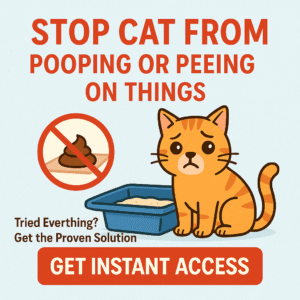Finding your cat peeing outside the litter box can feel both frustrating and puzzling—but it’s never just “bad behavior.” It’s a sign something’s off: medical issues, stress, environmental confusion, or box aversion. You deserve clear, practical solutions to stop this—and fast.
In this guide, you’ll discover the underlying causes, actionable fixes you can implement today, and how to prevent it from becoming a long-term habit. Plus, when you use the structured approach in the Cat Spray No More ebook, you’re setting up lasting routines that stop accidents before they start.
1. Don’t Skip the Vet Visit
Quick answer: Urinary tract infections (UTIs), bladder crystals or stones, kidney disease, diabetes, arthritis, and other medical issues are the most common causes. They make peeing painful or confusing, so your cat avoids the litter box.
Action Step: Schedule a vet visit with urinalysis, blood tests, and a physical exam. Treating any condition promptly is often the fastest path to stopping accidents.
2. Litter Box Setup: Key to Correct Use
Even healthy cats can pee outside the box if something about it doesn’t work for them. Focus on four critical factors:
🔁 Box Quantity
- Use one box per cat, plus one extra—so if you have two cats, use three boxes.
🧼 Cleanliness
- Make scooping a daily habit—and refresh the entire box weekly with unscented soap.
- Instant scoops after use encourage consistency.
📏 Size, Type & Litter
- Open, low-sided boxes work best for clarity and comfort.
- Choose large boxes—many cats need length plus room to turn.
- Use unscented, fine-grain clumping litter to accommodate sensitive noses.
📍 Location
- Place boxes in quiet, low-traffic areas—but not tucked away in far corners.
- Avoid sharing space with noisy appliances like washing machines.
- Ensure each box is accessible—with no steps, doors, or clutter blocking them.
3. Stress & Environmental Factors
Environmental stress is a major reason cats pee outside the box. Common stressors include new pets, guests, renovations, neighborhood cats, or changes in daily routine.
- Use pheromone diffusers near litter areas to create feelings of calm and safety.
- Provide hiding spots and vertical spaces for comfort and escape from stress.
- Stick to routines: regular feeding, play, and cleaning schedules help your cat feel secure.
4. Territorial Marking vs. Accidental Urination
Marking behavior looks different than accidents. Noticing the pattern helps with strategy:
- Marking clues: Spraying, vertical surfaces, tail up posture—often seen in unneutered or stressed cats.
- Accident clues: Wet patches on horizontal surfaces like carpets, beds, or clothes—usually unintentional.
For marking, spaying/neutering and eliminating triggers like outdoor cats help. For accidents, focus on comfort and calming the environment.
5. Clean Thoroughly to Prevent Repeat Behavior
Surface cleaning isn’t enough—urine scent remains at the microscopic level and attracts repeat accidents.
- Use enzyme-based cleaners that fully break down urine.
- Saturate deeply: soak carpets, pads, and upholstery thoroughly.
- Air-dry completely after cleaning to prevent residual odor.
- Add a waterproof barrier like a mattress pad or furniture cover until you’re certain the smell is gone.
6. Behavioral Redirection & Reward-Based Training
Catch your cat heading to pee outside the box and gently guide them to it. When they use it correctly, reinforce immediately with praise, petting, or small treats. Ignore mistakes—punishment increases stress and prolongs the issue.
7. Create a Comfortable, Cat-Friendly Space
- Install multiple boxes: On different levels, away from food/water.
- Provide vertical access: Cat trees or shelves help your cat feel safe.
- Keep enrichment tools: Puzzles, scratching posts, safe toys, and cozy beds in quiet spaces build relaxation.
8. Establish Supportive Routines and Tracking
The Cat Spray No More ebook emphasizes daily routines, tracking habits, and maintenance checklists—all key for accident prevention:
- Track accidents: Log what happened, when, and where to identify patterns.
- Set cleaning reminders: A scheduled weekly box refresh prevents aversion.
- Routine feeding & play: Helps calm behavior and set the litter box schedule.
9. When to Consult a Professional
- Persistent accidents two weeks after cleaning, redirection, and box adjustment.
- Signs of marking behavior—even despite clean boxes.
- Changes in appetite, weight, behavior, or signs of pain.
- Multi-cat stress, conflict, or hidden anxiety factors.
In these cases, consider help from a certified cat behavior consultant or veterinary behaviorist for customized support.
Real-Life Recovery Story
“Leo began urinating on our bedroom rug after we moved apartments. We ruled out medical reasons, then followed a plan: three open boxes, deep-clean with enzyme spray, blocked bedroom access at night, added Feliway diffusers, and tracked accidents per the ebook’s logs. Within ten days, Leo returned to all boxes, and the rug remained dry ever since.”
14-Day Rescue Roadmap: Stop Peeing Outside the Box
| Days | Focus Area | Action Steps |
|---|---|---|
| 1–2 | Vet & Cleanup | Check for health issues; deep-clean all accident areas with enzyme products |
| 3–5 | Litter Box Setup | Add boxes (one per cat +1), ensure open design, fill with fresh fine litter |
| 6–9 | Calm Environment | Add pheromone diffusers; create hiding & vertical zones; re-establish routine |
| 10–14 | Training & Rewards | Redirect accidents to box; reward box use; monitor log daily |
| 15+ | Maintain & Evaluate | Weekly cleaning; reinforce routine; consult professional if needed |
Signs of Success
- Week 1: Reduced accidents and improved box behavior
- Week 2–4: Overnight dryness, consistent litter use
- 1–2 months: Routine fully established, minimal or no accidents
- 3+ months: Stable habits and a calm, confident cat
Final Thoughts: Take Control with Compassion & Consistency
Cat peeing outside the litter box isn’t misbehavior—it’s a sign your cat needs help. With vet care, better box routines, environmental enrichment, and systematic tracking—especially using methods in the Cat Spray No More ebook—you’re giving your cat comfort, structure, and support to succeed.
Download Cat Spray No More now and take the first confident steps toward a cleaner, calmer home—and a happier cat.
